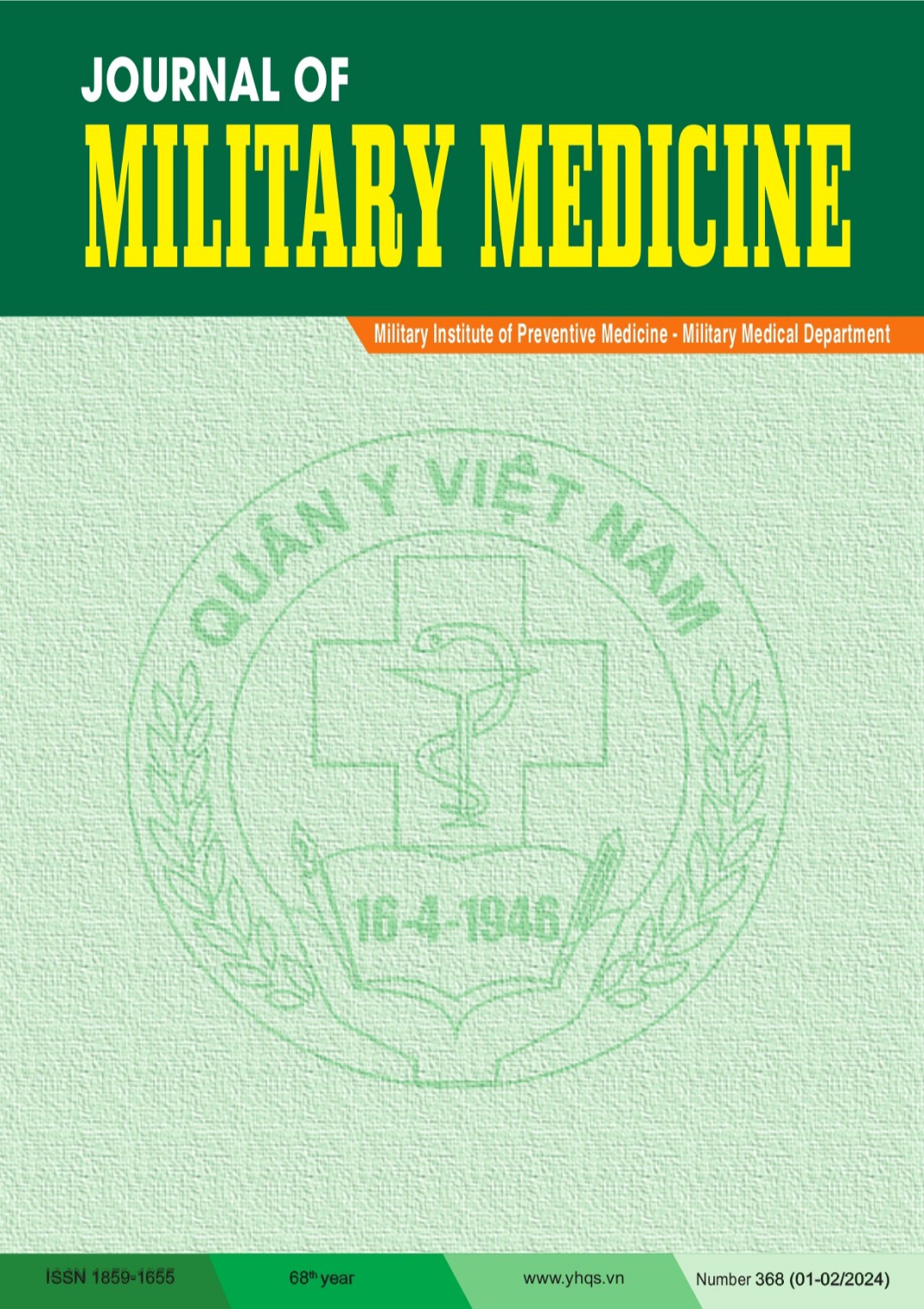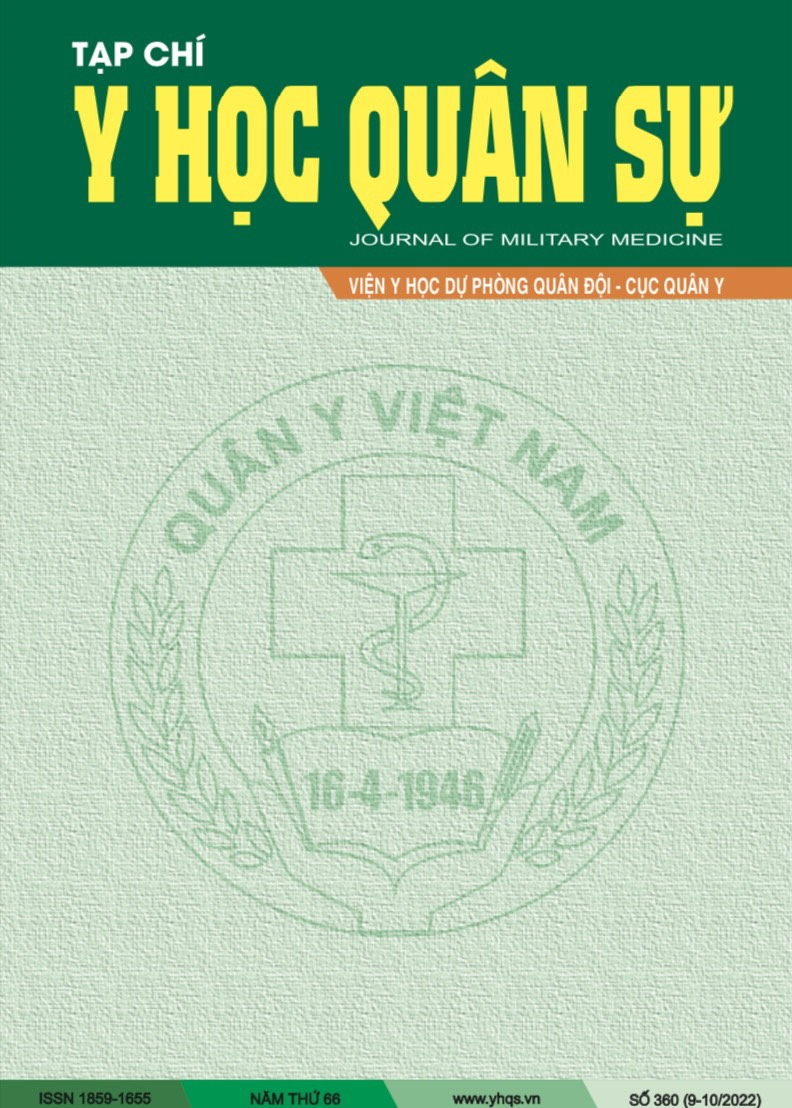CIRCULATING PROTEINS AS DIAGNOSTIC BIOMARKERS IN BREAST CANCER
DOI:
https://doi.org/10.59459/1859-1655/JMM.345Từ khóa:
Breast cancer, biomarkers, diagnosis, proteinTóm tắt
Purpose: Summary of tumor-produced circulating proteins as biomarkers in breast cancer (BC) detection.
Subjects and method: A meta-analysis of 50 researches on protein biomarkers in BC diagnosis.
Results: Many studies have shown that tumors continuously release components such as protein, RNA, and DNA into the bloodstream during apotosis. There are different protein markers, as tissue markers and serum markers involved assisting diagnosis, but none of them can independently establish the final diagnotic BC at an early stage. Therefore, scientific communities have been putting lots of effort to discover biomarkers for better identifying this malignant disease at earlier stages.
Tài liệu tham khảo
Arnold M., et al (2022), “Current and future burden of breast cancer: Global statistics for 2020 and 2040”, Breast, 2022, 66: p. 15-23.
He Z., et al (2020), “A review on methods for diagnosis of breast cancer cells and tissues”, Cell Prolif, 2020, 53 (7): p. e12822.
Harris L., et al (2007), “American Society of Clinical Oncology 2007 update of recommendations for the use of tumor markers in breast cancer”, J Clin Oncol, 2007, 25 (33): p. 5287-312.
Buist D.S., et al (2004), “Factors contributing to mammography failure in women aged 40-49 years”, J Natl Cancer Inst, 2004, 96 (19): p. 1432-40.
Robert D. Rosenberg, M., et al., Effects of Age, Breast Density, Ethnicity, and Estrogen Replacement Therapy on Screening Mammographic Sensitivity and Cancer Stage at Diagnosis: Review of 183,134 Screening Mammograms in Albuquerque, New Mexico. Radiology, 1998. 209: p. 511-518.
Bidard, F.C., et al., Clinical validity of circulating tumour cells in patients with metastatic breast cancer: a pooled analysis of individual patient data. Lancet Oncol, 2014. 15(4): p. 406-14.
Woodhouse, R.A.-O., et al., Clinical and analytical validation of FoundationOne Liquid CDx, a novel 324-Gene cfDNA-based comprehensive genomic profiling assay for cancers of solid tumor origin. PLoS One, 2020. 15(9)(1932-6203 (Electronic)).
Baghban R., et al (2020), “Tumor microenvironment complexity and therapeutic implications at a glance”, Cell Commun Signal, 2020, 18 (1): p. 59.
Afzal, S., et al., Breast Cancer; Discovery of Novel Diagnostic Biomarkers, Drug Resistance, and Therapeutic Implications. Front Mol Biosci, 2022. 9: p. 783450.
Kathrikolly T., et al (2022), “Can serum autoantibodies be a potential early detection biomarker for breast cancer in women? A diagnostic test accuracy review and meta-analysis”, Syst Rev, 2022, 11 (1): p. 215.
Lee Y.J., et al (2022), “The blood level of thioredoxin 1 as a supporting biomarker in the detection of breast cancer”, BMC Cancer, 2022, 22 (1): p. 12.
Sermaxhaj F et al (2022), “The role of interleukin-7 serum level as biological marker in breast cancer: a cross-sectional, observational, and analytical study”, World J Surg Oncol, 2022, 20 (1): p. 225.
Fredolini C., et al (2020), “Shotgun proteomics coupled to nanoparticle-based biomarker enrichment reveals a novel panel of extracellular matrix proteins as candidate serum protein biomarkers for early-stage breast cancer detection”, Breast Cancer Res, 2020, 22 (1): p. 135.
Nour Eldin E.E.M., et al (2020), “Evaluation of the Diagnostic and Predicative Values of 8-Iso-Prostaglandin F2alpha as a Biomarker of Breast Cancer”, Oncol Res Treat, 2020, 43 (10): p. 506-517.
Motawi T.M., et al (2020), “Significance of Some Non-Invasive Biomarkers in the Early Diagnosis and Staging of Egyptian Breast Cancer Patients”, Asian Pac J Cancer Prev, 2020, 21 (11): p. 3279-3284.
Bademler S., et al (2019), “Clinical Significance of Serum Membrane-Bound Mucin-2 Levels in Breast Cancer”, Biomolecules, 2019, 9 (2).
Qiu C., et al (2021), “Identification of novel autoantibody signatures and evaluation of a panel of autoantibodies in breast cancer”, Cancer Sci, 2021, 112 (8): p. 3388-3400.
Bartkowiak K., et al (2022), “Circulating Cellular Communication Network Factor 1 Protein as a Sensitive Liquid Biopsy Marker for Early Detection of Breast Cancer”, Clin Chem, 2022, 68 (2): p. 344-353.
Ping Li Q.H. (2015), “Chenqun Luo, Liyuan Qian, Diagnostic and prognostic potential of serum angiopoietin-2 expression in human breast cancer”, Int J Clin Exp Pathol, 2015, 8 (1): p. 660-664.
Lacombe J., et al (2013), “Identification and validation of new autoantibodies for the diagnosis of DCIS and node negative early-stage breast cancers”, Int J Cancer, 2013, 132 (5): p. 1105-13.
Xue F., Y. Meng, and J. Jiang (2022), “Diagnostic Value of Dynamic Enhanced Magnetic Resonance Imaging Combined with Serum CA15-3, CYFRA21-1, and TFF1 for Breast Cancer”, J Healthc Eng, 2022, p. 7984591.
Lee S.B., et al (2020), “Breast cancer diagnosis by analysis of serum N-glycans using MALDI-TOF mass spectroscopy”, PLoS One, 2020, 15 (4): p. e0231004.
Karlenius, T.C. and K.F. Tonissen, Thioredoxin and Cancer: A Role for Thioredoxin in all States of Tumor Oxygenation. Cancers (Basel), 2010. 2(2): p. 209-32
Cha M.K., K.H. Suh, and I.H. Kim (2009), “Overexpression of peroxiredoxin I and thioredoxin1 in human breast carcinoma”, J Exp Clin Cancer Res, 2009, 28 (1): p. 93.
Gao J., et al (2015), “Mechanism of Action of IL-7 and Its Potential Applications and Limitations in Cancer Immunotherapy”, Int J Mol Sci, 2015, 16 (5): p. 10267-80.
Gago-Dominguez M., X. Jiang, and J.E. Castelao (2007), “Lipid peroxidation, oxidative stress genes and dietary factors in breast cancer protection: a hypothesis”, Breast Cancer Res, 2007, 9 (1): p. 201.
Nichols, H.B., et al., Oxidative Stress and Breast Cancer Risk in Premenopausal Women. Epidemiology, 2017. 28 (5): p. 667-674.
Milne, G.L., J.D. Musiek Es Fau - Morrow, and J.D. Morrow, F2-isoprostanes as markers of oxidative stress in vivo: an overview. Biomarkers, 2005. 10(1354-750X (Print)).
Zhu, Q.D.a.X., F2-isoprostanes and Metabolite, and Breast Cancer Risk. N Am J Med Sci (Boston), 2009. 2 (3): p. 106-108.
Miyazaki, Y., et al., Urinary 8-iso PGF2alpha and 2,3-dinor-8-iso PGF2alpha can be indexes of colitis-associated colorectal cancer in mice. PLoS One, 2021. 16 (1): p. e0245292.
Gao, X., et al., Urinary 8-isoprostane levels and occurrence of lung, colorectal, prostate, breast and overall cancer: Results from a large, population-based cohort study with 14 years of follow-up. Free Radic Biol Med, 2018. 123: p. 20-26.
Richelle, M., et al., Urinary isoprostane excretion is not confounded by the lipid content of the diet. FEBS Lett, 1999. 459 (2) (0014-5793 (Print)): p. 259-62.
Ullrich, N., et al., CEACAM1-3S Drives Melanoma Cells into NK Cell-Mediated Cytolysis and Enhances Patient Survival. Cancer Res, 2015. 75 (9) (1538-7445 (Electronic)): p. 1897-907.
Deb, A., et al., Resistin: A journey from metabolism to cancer. Transl Oncol, 2021. 14 (10) (1936-5233 (Print)).
Heo, Y.J., et al., Visfatin Induces Inflammation and Insulin Resistance via the NF-κB and STAT3 Signaling Pathways in Hepatocytes. J Diabetes Res, 2019 (2314-6753 (Electronic)).
Park, H.J., et al., Visfatin promotes cell and tumor growth by upregulating Notch1 in breast cancer. Oncotarget., 2014. 5 (13) (1949-2553 (Electronic)): p. 5087-99.
Christodoulatos, G.S., et al., The Role of Adipokines in Breast Cancer: Current Evidence and Perspectives. Curr Obes Rep., 2019. 8 (4) (2162-4968 (Electronic)): p. 413-433.
Hollingsworth, M.A. and B.J. Swanson, Mucins in cancer: protection and control of the cell surface. Nat Rev Cancer, 2004. 4(1): p. 45-60.
Astashchanka, A., T.M. Shroka, and B.M. Jacobsen, Mucin 2 (MUC2) modulates the aggressiveness of breast cancer. Breast Cancer Res Treat, 2019. 173 (2): p. 289-299.
Wang, H., et al., Expression of survivin, MUC2 and MUC5 in colorectal cancer and their association with clinicopathological characteristics. Oncol Lett, 2017. 14 (1): p. 1011-1016.
Levi, E., et al., MUC1 and MUC2 in pancreatic neoplasia. J Clin Pathol, 2004. 57 (5): p. 456-62.
Cozzi, P.J., et al., MUC1, MUC2, MUC4, MUC5AC and MUC6 expression in the progression of prostate cancer. Clin Exp Metastasis, 2005. 22 (7): p. 565-73.
Kim, H., S. Son, and I. Shin, Role of the CCN protein family in cancer. BMB Rep, 2018. 51 (10): p. 486-492.
Yu, X. and F. Ye, Role of Angiopoietins in Development of Cancer and Neoplasia Associated with Viral Infection. Cells, 2020. 9 (2).
Sfiligoi, C., et al., Angiopoietin-2 expression in breast cancer correlates with lymph node invasion and short survival. Int J Cancer, 2003. 103 (4): p. 466-74.
Taniguchi, N. and Y. Kizuka, Glycans and cancer: role of N-glycans in cancer biomarker, progression and metastasis, and therapeutics. Adv Cancer Res, 2015. 126 (2162-5557 (Electronic)): p. 11-51.
De Jonge, H., et al., Anti-Cancer Auto-Antibodies: Roles, Applications and Open Issues. Cancers (Basel), 2021. 13 (4).
Nakata, B., et al., Serum CYFRA 21-1 (cytokeratin-19 fragments) is a useful tumour marker for detecting disease relapse and assessing treatment efficacy in breast cancer. Br J Cancer, 2004. 91 (5): p. 873-8.
Perry, J.K., et al., Are trefoil factors oncogenic? Trends Endocrinol Metab, 2008. 19 (2): p. 74-81.
Tải xuống
Đã Xuất bản
Cách trích dẫn
Số
Chuyên mục
Chấp nhận đăng 13-12-2023
Ngày xuất bản 28-02-2024



